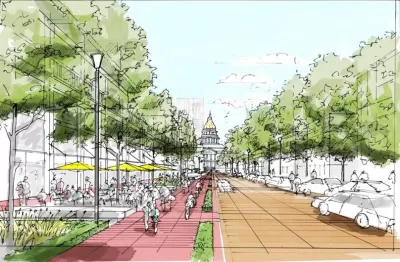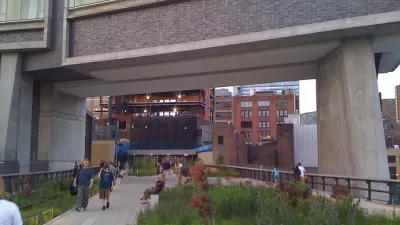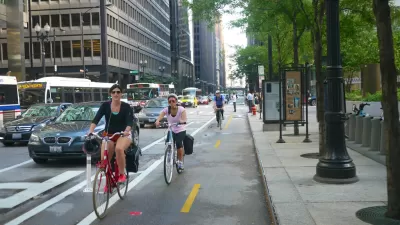The first section of the 5280 Trail, ready for design work in Denver, is already being compared to the High Line in New York City.

"A new urban trail that’s taking firmer shape in Denver — at least on drawing boards — would snake through several downtown neighborhoods for more than five miles, serving as a linear park as much as a way to get around," explains Jon Murray.
Murray is also reporting that the 5280 Trail proposal seems to be picking up momentum with Denver officials and private boosters, who say the first segment of the project is ready to go to formal design. The project "could break ground along a small stretch of 21st Street in the next two years or so, and the city has committed $850,000 to get the ball rolling on designs," according to Murray.
Still, there's a lot of work to be done before anyone should expect to stroll along a new linear park designed to achieve some of the same charms as the High Line in New York City. "One advocate predicted a need for 'significant”' contributions from private donors," according to Murray. If all goes well, construction could take place in increments over the next decade, starting as soon as two years from now.
The 5280 Trail, formerly referred to as the 5280 Loop, would total 5.3 miles, "[traveling] along 21st from Coors Field to Benedict Fountain Park, and from there the conceptual route heads south on Sherman Street, going around the State Capitol; traverses the Golden Triangle neighborhood and crosses the Art District on Santa Fe; and heads north through the Auraria Campus before crossing Speer Boulevard and Cherry Creek into Lower Downtown, where it follows Wynkoop Street past Union Station, returning to the ballpark."
FULL STORY: 5280 Trail aims to be Denver’s answer to New York City’s High Line

Alabama: Trump Terminates Settlements for Black Communities Harmed By Raw Sewage
Trump deemed the landmark civil rights agreement “illegal DEI and environmental justice policy.”

Planetizen Federal Action Tracker
A weekly monitor of how Trump’s orders and actions are impacting planners and planning in America.

The 120 Year Old Tiny Home Villages That Sheltered San Francisco’s Earthquake Refugees
More than a century ago, San Francisco mobilized to house thousands of residents displaced by the 1906 earthquake. Could their strategy offer a model for the present?

LA’s Tree Emergency Goes Beyond Vandalism
After a vandal destroyed dozens of downtown LA trees, Mayor Karen Bass vowed to replace them. Days later, she slashed the city’s tree budget.

Sacramento Leads Nation With Bus-Mounted Bike Lane Enforcement Cameras
The city is the first to use its bus-mounted traffic enforcement system to cite drivers who park or drive in bike lanes.

Seattle Voters Approve Social Housing Referendum
Voters approved a corporate tax to fund the city’s housing authority despite an opposition campaign funded by Amazon and Microsoft.
Urban Design for Planners 1: Software Tools
This six-course series explores essential urban design concepts using open source software and equips planners with the tools they need to participate fully in the urban design process.
Planning for Universal Design
Learn the tools for implementing Universal Design in planning regulations.
Ada County Highway District
Clanton & Associates, Inc.
Jessamine County Fiscal Court
Institute for Housing and Urban Development Studies (IHS)
City of Grandview
Harvard GSD Executive Education
Toledo-Lucas County Plan Commissions
Salt Lake City
NYU Wagner Graduate School of Public Service





























